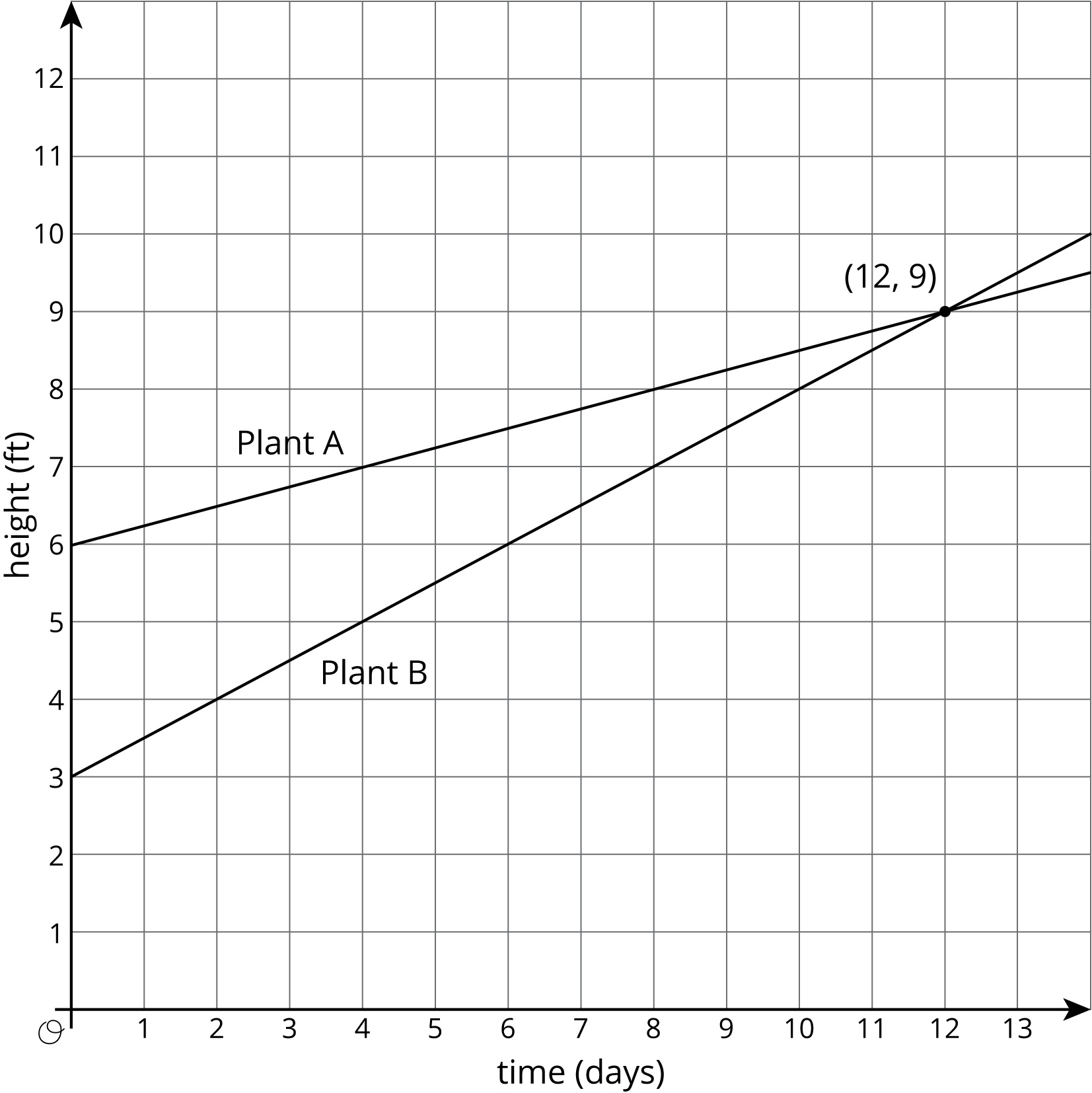Lesson 13
Systems of Equations
Let’s learn what a system of equations is.
13.1: Milkshakes
Diego and Lin are drinking milkshakes. Lin starts with 12 ounces and drinks \(\frac14\) ounce per second. Diego starts with 20 ounces and drinks \(\frac23\) ounce per second.
- How long will it take Lin and Diego to finish their milkshakes?
- Without graphing, explain what the graphs in this situation would look like. Think about slope, intercepts, axis labels, units, and intersection points to guide your thinking.
- Discuss your description with your partner. If you disagree, work to reach an agreement.
13.2: Passing on the Trail
There is a hiking trail near the town where Han and Jada live that starts at a parking lot and ends at a lake. Han and Jada both decide to hike from the parking lot to the lake and back, but they start their hikes at different times.
At the time that Han reaches the lake and starts to turn back, Jada is 0.6 miles away from the parking lot and hiking at a constant speed of 3.2 miles per hour toward the lake. Han’s distance, \(d\), from the parking lot can be expressed as \(d = \text-2.4t+4.8\), where \(t\) represents the time in hours since he left the lake.
-
What is an equation for Jada’s distance from the parking lot as she heads toward the lake?
-
Draw both graphs: one representing Han’s equation and one representing Jada’s equation. It is important to be very precise.
-
Find the point where the two graphs intersect each other. What are the coordinates of this point?
-
What do the coordinates mean in this situation?
-
What has to be true about the relationship between these coordinates and Jada’s equation?
-
What has to be true about the relationship between these coordinates and Han’s equation?
13.3: Stacks of Cups
A stack of \(n\) small cups has a height, \(h\), in centimeters of \(h=1.5n+6\). A stack of \(n\) large cups has a height, \(h\), in centimeters of \(h=1.5n+9\).
-
Graph the equations for each cup on the same set of axes. Make sure to label the axes and decide on an appropriate scale.
- For what number of cups will the two stacks have the same height?
Summary
A system of equations is a set of 2 (or more) equations where the variables represent the same unknown values. For example, suppose that two different kinds of bamboo are planted at the same time. Plant A starts at 6 ft tall and grows at a constant rate of \(\frac14\) foot each day. Plant B starts at 3 ft tall and grows at a constant rate of \(\frac12\) foot each day. We can write equations \(y = \frac14 x + 6\) for Plant A and \(y = \frac12 x +3\) for Plant B, where \(x\) represents the number of days after being planted, and \(y\) represents height. We can write this system of equations.
\(\displaystyle \begin{cases} y = \frac14 x + 6 \\ y = \frac12 x +3 \end{cases}\)
Solving a system of equations means to find the values of \(x\) and \(y\) that make both equations true at the same time. One way we have seen to find the solution to a system of equations is to graph both lines and find the intersection point. The intersection point represents the pair of \(x\) and \(y\) values that make both equations true. Here is a graph for the bamboo example:

The solution to this system of equations is \((12,9)\), which means that both bamboo plants will be 9 feet tall after 12 days.
We have seen systems of equations that have no solutions, one solution, and infinitely many solutions.
- When the lines do not intersect, there is no solution. (Lines that do not intersect are parallel.)
- When the lines intersect once, there is one solution.
- When the lines are right on top of each other, there are infinitely many solutions.
In future lessons, we will see that some systems cannot be easily solved by graphing, but can be easily solved using algebra.
Glossary Entries
- system of equations
A system of equations is a set of two or more equations. Each equation contains two or more variables. We want to find values for the variables that make all the equations true.
These equations make up a system of equations:
\(\displaystyle \begin{cases} x + y = \text-2\\x - y = 12\end{cases}\)
The solution to this system is \(x=5\) and \(y=\text-7\) because when these values are substituted for \(x\) and \(y\), each equation is true: \(5+(\text-7)=\text-2\) and \(5-(\text-7)=12\).